California Capitol Reroofing Crew Reflects Complex Project
The work crew on the capitol’s roof during the project went beyond just the installers, and it reflected the complex nature of the work.
“We had an engineer on staff at all times to witness what we were doing,” says Robin Libby, the capitol’s office building manager. An inspector of record also was present.
“He inspected the roof as it was being demolished and as the new one was being installed,” Nelson says. “We also had an architect on call. He would come out as needed, either night or day.”
Finally, the building’s mechanical and electrical engineers provided crucial information to contractors about the building’s systems affected by the reroofing project.
“The stationary engineers that do the hands-on operation of the building provide a lot of access, and they have a lot of institutional knowledge about how things work, whether it’s roof drains or how to get from one location to another on the roof, and that’s a big part of it,” Manning says. “If (the contractors) need electrical for any work on the roof, we end up supplying that for them because there isn’t always what you need where you need it.”
Access considerations
The reroofing project on the California state capitol also presented managers with logistical and material issues related to both the size of the facility and its age.
“First, we had to get the material up and down, so we had to install an elevator, which is problematic on a historic building,” Nelson says. “We ended up doing it on the east wing. We brought up some material via the elevator and dispersed it throughout the roof so the load on the roof would be correct. We also had to have several cranes and lift equipment, and we had air handler units that were changed out at the same time, as well as the skylights above both the Senate and the House sides.”
But access to the roof was a consideration not only when it came to roofing materials and equipment. Managers also had to plan for access by work crews.
“We had the issues of getting everyone fingerprinted and badged,” Nelson says. “Every time we brought in a truck, we had to involve the (California Highway Patrol). Depending on where we were working in the building, we’d have the governor’s security staff, as well.”
The challenges were not necessarily new, just broader in scope because of the size of the project.
“We go through it every time we bring in a contractor of any type,” Manning says. “There’s a background check that’s done on the employees, and their vehicles have to be inspected by the highway patrol. Being a politically occupied building, it has been a target, so there are a lot of measures to prevent it from being a target again.”
Even the building’s location presented security issues for managers.
“The capitol sits in the middle of a 42-acre public park in downtown Sacramento, so it’s vulnerable from all sides,” Libby says. “We have an extensive bollard system that goes up and down to allow vehicles into the park around the building. So it’s quite a coordination effort.”
Related Topics:













